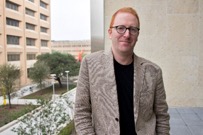Solid-State and Nano Seminar
The Mid-Infrared as an Optical Playground
IEEE Photonics Society Distinguished LecturerUniversity of Texas at Austin, Microelectronics Research Center

Prof. Wasserman is an IEEE Photonics Society Distinguished Lecturer, and the seminar is co-sponsored with ECE Solid State and Nanotechnology Group and IEEE Southeastern Michigan Trident Chapter IV. Refreshments will be provided. Faculty may schedule meetings with Prof. Wasserman during his visit using the EECS visitor scheduling tool.
The mid-infrared (mid-IR) spectral range (loosely defined as the wavelengths between 3-30Â µm) has become a burgeoning and dynamic field of research for a variety of technologically vital applications. Nonetheless, the development of the mid-IR optical infrastructure still trails behind that of the shorter, more mature, telecom and visible wavelength ranges. This can be viewed as a drawback of mid-IR photonics research (more expensive, limited efficiency components and materials), or alternatively, as an opportunity. In particular, the mid-IR provides a design space where a wide range of engineered and intrinsic light matter interactions can be harnessed to develop a new generation of optical materials.
Professor Wasserman will discuss his recent work developing novel optoelectronic, all-dielectric, plasmonic and phononic devices and structures for mid-IR wavelength applications. In particular, a range of phenomena which can be leveraged to demonstrate unique designer materials, mid-IR devices, and novel characterization techniques will be discussed. He will cover his work on new types of mid-IR sources, ENZ materials and waveguides, mid-IR filters, engineered thermal emitters, and designer plasmonic materials and structures for strong absorption and subwavelength confinement. Ultimately in this seminar, he will make an effort to demonstrate that the mid-IR provides a unique materials playground for the exploration, and implementation, of a range of light-matter interactions.
Dan Wasserman is an Associate Professor of Electrical and Computer Engineering at the University of Texas Austin, where he is affiliated with the Microelectronics Research Center. Prof. Wasserman earned his Sc.B. degree in Engineering/Physics and History from Brown University in 1998, graduating Summa Cum Laude, Phi Beta Kappa, with Honors. He attended graduate school at Princeton University, earning a National Science Foundation Graduate Fellowship, and receiving his Master's and Doctorate in Electrical Engineering in 2000 and 2004, respectively. Upon completion of the Ph.D. program, Dr. Wasserman was awarded a Princeton University Council on Science and Technology Post-Doctoral Fellowship, and spent the next years working on quantum cascade lasers and developing a hands-on optics course at Princeton. In 2007, Dr. Wasserman joined the University of Massachusetts Lowell faculty as an Assistant Professor in the Department of Physics and Applied Physics. In 2007, Prof. Wasserman joined the faculty of the Electrical and Computer Engineering Department at the University of Illinois Urbana Champaign, in the Micro and Nanotechnology Lab, becoming an Associate Professor in 2015. In 2016, Professor Wasserman joined the University of Texas at Austin. Prof. Wasserman is the recipient of the NSF CAREER award and the AFOSR Young Investigator Award, as well as the UIUC Distinguished Promotion Award, and Teaching and Advising awards and commendations at UMass and Illinois.
 MENU
MENU 
